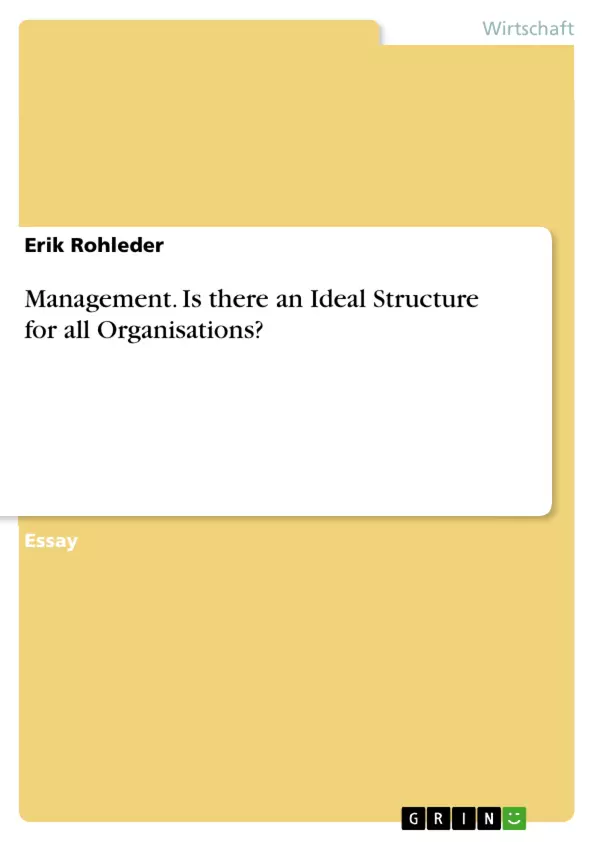Since there are organisations, the respective management has to decide how to divide its work, how to coordinate all work-related activities and how to control these activities to ensure that goals are achieved. Ever since these issues, people discussed the question whether there is an ideal structure for all organisations!? This essay will show various influences on such a choice and that it is not possible to define an ideal organisation structure. However, to answer this question, it is necessarily to define the words organisation structure, organisation design, and to consider the various factors that impact upon it.
Therefore, an organisational structure is the formal framework by which job tasks are divided, grouped and coordinated (Robbins, 2004). These formal arrangements are closely related to an organisational design. By developing or changing an organisation’s structure, managers are engaged in organisational design. This process involves decisions about six key elements: work specialisation, departmentalization, chain of command, span of control, centralisation and decentralisation, and formalisation (Daft, 2004). Both organisational structure and organisational design are influenced by many factors, which led to a multitude of different structures. One of them is the bureaucratic model of organisations. Although its roots go back several centuries, it is most often associated with the work of Max Weber, a German sociologist. He was one of the few people who tried to describe an ideal approach to structuring organisations based on a rational set of guidelines and procedures (Weber, 1983). Furthermore, Weber drew attention to “the way in which more personal styles of administration, centered on the king were supplanted by rational/legal organisational structures” (Colebatch, 1993). Thus, the bureaucracy was meant to organise the work of many individuals and centralise orders without having direct contact to each person. Another common organisation is the matrix. It is created by overlaying product-based departmentalisation onto a functional structure. This type of organisation is used in the aerospace industry, where projects are technically complex. Hundreds of subcontractors, located throughout the whole world, are involved and therefore, organised by this matrix structure.
Inhaltsverzeichnis
- Is there an ideal structure for all organisations?
- Organisational Structure and Organisational Design
- The Bureaucratic Model
- The Matrix Organisation
- Generic Models of Organisational Design
- The Mechanistic Organisation
- The Organic Organisation
- Contingency Variables
- Organisation's Size
- Technology
- Environment
- Organisational Strategy
- Conclusion
- Bibliography
Zielsetzung und Themenschwerpunkte
Dieser Essay befasst sich mit der Frage, ob es eine ideale Organisationsstruktur für alle Unternehmen gibt. Er analysiert verschiedene Einflussfaktoren auf die Wahl einer Organisationsstruktur und argumentiert, dass es keine allgemeingültige ideale Struktur gibt. Der Essay beleuchtet die Definitionen von Organisationsstruktur und Organisationsdesign und untersucht die verschiedenen Faktoren, die diese beeinflussen.
- Einflussfaktoren auf die Organisationsstruktur
- Verschiedene Organisationsmodelle (z.B. bürokratisches Modell, Matrixorganisation)
- Mechanistische und organische Organisationsstrukturen
- Kontingenzfaktoren (Größe, Technologie, Umwelt, Strategie)
- Beziehung zwischen Organisationsstruktur und Unternehmenserfolg
Zusammenfassung der Kapitel
Der Essay beginnt mit einer Einführung in die Thematik der Organisationsstruktur und des Organisationsdesigns. Er definiert diese Begriffe und erläutert, wie sie sich gegenseitig beeinflussen. Anschließend werden verschiedene Organisationsmodelle vorgestellt, darunter das bürokratische Modell und die Matrixorganisation. Der Essay geht dann auf die beiden generischen Modelle des Organisationsdesigns ein: die mechanistische und die organische Organisation. Er beschreibt die Eigenschaften beider Modelle und gibt Beispiele für Unternehmen, die diese Strukturen anwenden.
Im nächsten Abschnitt werden die vier Kontingenzfaktoren untersucht, die die Wahl der Organisationsstruktur beeinflussen: Größe, Technologie, Umwelt und Strategie. Der Essay analysiert den Einfluss jedes Faktors auf die Struktur und zeigt, wie sie die mechanistische oder organische Organisation begünstigen. Es wird beispielsweise erläutert, wie die Größe eines Unternehmens die Komplexität der Kommunikation und die Notwendigkeit für eine mechanistische Struktur beeinflusst. Ebenso wird der Einfluss der Technologie auf die Struktur untersucht, wobei die Forschung von Joan Woodward hervorgehoben wird, die die Beziehung zwischen Technologie und Organisationsstruktur erforscht hat.
Der Essay betrachtet auch den Einfluss der Umwelt auf die Organisationsstruktur. Er beschreibt, wie sich die Stabilität oder Instabilität der Umwelt auf die Wahl zwischen einer mechanistischen oder organischen Struktur auswirkt. Die Bedeutung von Unsicherheit und Volatilität für die Umwelt wird ebenfalls diskutiert. Schließlich wird der Einfluss der Organisationsstrategie auf die Struktur untersucht. Der Essay zeigt, wie verschiedene strategische Optionen, wie Innovation, Kostenminimierung und Imitation, die Wahl der Organisationsstruktur beeinflussen.
Schlüsselwörter
Die Schlüsselwörter und Schwerpunktthemen des Textes umfassen Organisationsstruktur, Organisationsdesign, bürokratisches Modell, Matrixorganisation, mechanistische Organisation, organische Organisation, Kontingenzfaktoren, Größe, Technologie, Umwelt, Strategie, Unternehmenserfolg.
- Quote paper
- Erik Rohleder (Author), 2010, Management. Is there an Ideal Structure for all Organisations?, Munich, GRIN Verlag, https://www.grin.com/document/152486



